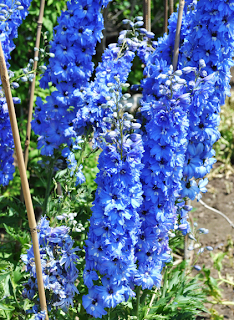I was impressed by his quote where he mentioned “… All of our
dreams are going to come true. So we will have to have the right kinds of
dreams. That is why science needs artists like me” (Lecture Part I). After
reading this quote, I was looking forward to seeing how artists and scientist
together define the relationship between biotechnology and art.
James Watson was introduced to use animals on bio art studies for
example using live cells. The lecture video shows the glowing mammals. Osamu
Shimomura was the one who worked with green fluorescent protein by injecting
the jellyfish gene to mice. Furthermore, this study helped detecting the
activity of spreading cancer cells to nerve cells and brain. Transgenic art and genetic engineering are used for
inventing unique and odd types of mammals and especially Alba, a glowing rabbit, became GFP Bunny that was famous for being an example
of a transgenic artwork. Alba is a cute and cuddly house pet, but when only the
UV light is turned on, it shows its glowing ear, body, paws, and even its
whiskers.
(Alba, the glowing rabbit)
The part I of lecture video shows how such glowing rabbit represent
the strange and unfamiliar form of so-called “a disconcerting vision of future
of a science fiction pet”. At this point, we should think about how art and
life inventions are affecting each other through interspecies communication and
dialogue by using artwork and technology with creativity. “Meanings of
Participation: Outlaw Biology?” article also talks about how “creativity breeds
creativity.” As a human being, we have the control over such innovations and new
expansion of creative ideas.
(Example of Orlan's idea)
Moreover, I was fascinated by the idea of Orlan from the lecture
part IV. Her idea was to use her body and the procedures of plastic surgery to show "carnal art". Her transformation presents the different color pieces from biotechnological symbols and also hybridization of different culture breeding.
Orlan’s idea plus “The third ear” gave me a new shock to the concept of
combination of art and biotechnology. I could not imagine how these kinds of
job were produced and introduced in communities.
(Connecticut Yankee delphinium plant)
On the other hand, among these artworks, I was interested in how
the artists work with nature. People studied not only animals’ genetics and
technology expand in human lives, but also focused on the breeding of
Connecticut Yankee delphinium plant. I was indifferent about how nature can be
the branch of art and biotechnology experiment, but I would like to visit one
of the flow exhibitions.
Citation & Sources
Eduardo Kac. "GFP Bunny". Dobrila, Peter T. and Kostic, Aleksandra (eds.), Eduardo Kac: Telepresence, Biotelematics, and Transgenic Art (Maribor, Slovenia: Kibla, 2000), pp. 101-13. Web. <http://www.ekac.org/gfpbunny.html#gfpbunnyanchor>
Animal Biotechnology. University of California Television. Jul 25, 2013. <http://www.youtube.com/watch?v=qCIvAuwaf-o>
Vesna, Victoria. Lecture I-V. DESMA 9. Web. 17 May. 2012
Kelty, Chris. “Meanings of Participation: Outlaw Biology?”. Web. 5 Nov. 2012.
Levy, Ellen K.. “Defining Life: Artists Challenge Conventional Classifications.” Web. 2 Nov 2012.



No comments:
Post a Comment